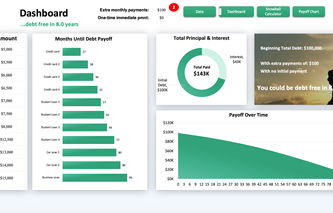If you’ve ever done any projections to imagine how much money you’d need to retire, you’ve probably thrown around large-sounding figures in the millions.
Let’s pick a number and figure out the interest you’d earn on it per month. Something like, "What is the interest on 2 million dollars?" I remember while growing up, I always imagined $1 million as that unattainable, “you’ve made it” number. Now, thanks to inflation and other factors, is $2 million a safer goal to retire on?
Similar articles:
How Much Interest Does One Million Dollars Earn per Month or Year in 2023?
Living off Interest of 3 Million Dollars (How Much Monthly Interest?)
What to Do With 4 Million Dollars and Can You Live off the Interest?
How Much Interest Will I Earn on $5 Million? Would It Be Enough To Live On?
How Much Interest on 10 Million Dollars Would I Earn? (Annually & Per Month)
What Is The Yearly Interest on 20 Million Dollars? What's the Lifestyle?
Where Do You Put $100 Million Dollars? What Will It Earn in a Bank Account?
Yearly Interest on 1 Billion Dollars: What Does it Look Like?
What Is The Interest on 2 Million Dollars?
The interest on $2 million, if left to compound at 2%, would be $40,000 a year. However, high-yield savings accounts can have interest rates as low as 0.6%, netting just $12,000 a year in interest on $2 million, if left in the bank.
Let’s say you decide that $2 million is the amount you can expect to have stashed before you retire. Let that money pay the bills for as many retirement years as possible. You’ll need to take into account the interest rate you earn on your investment principal and how often the interest compounds.
For simplicity, let’s say you have additional capital that allows you to pay your bills, and you’re leaving the entire $2 million invested long-term. If your money compounds annually, here’s the interest on $2 million (ie. the potential answer to the question, "what is the interest on 2 million dollars"....if it were left alone and reinvested?):
2% interest for 20 years = total after 20 years of $2,971,895
4% interest for 20 years = total after 20 years of $4,382,246
6% interest for 20 years = total after 20 years of $6,414,271
8% interest for 20 years = total after 20 years of $9,321,914
Interested in becoming wealthy yourself? The year 2023 was a good one for Yieldstreet and Crowdstreet for passive income. Here's our Crowdstreet review if you're interested.
What is the Interest on 2 Million Dollars a Year?
The yearly interest on $2 million depends on how investments are held. With a 0.5% savings account, the interest on $2 million would be $10,000, but with a 1% Government bond, yearly interest would double to $20,000.
With money in real estate, at 7% interest, $2 million would make $140,000 a year. The question of how much 2 million dollars can generate per year is a great one, but it’s not the easiest answer to give since there are so many investment options.
Based on my research and my experience, you can expect to get the below rates for the respective investments.
Savings: 0.5%
Certificate of Deposit: 0.65%
Short term government bond: 1%
Short term corporate bond: 2-3%
Annuity: 3%
Real Estate: 7%
S&P 500 Index Fund: 10%
Check out our list of the 10 best investment apps for more.
The real estate percentage is my estimate based on the crazy price of homes today (rental rates have not kept up with housing prices). And, the S&P 500 is based on thehistorical average when including dividend reinvestment.
So now to answer the question of “what is the yearly interest on 2 million dollars?”
With a 0.5% savings account: $10,000 a year
1% government bond: $20,000 a year
3% annuity: $60,000 a year
7% real estate: $140,000 a year
And, 10% in S&P 500: $200,000 per year
Whoa! Seems like a no-brainer, right? Put all the money in the stock market, right?? Not so fast. There’s also the factor of risk.
Putting 2 million dollars in the stock market is much more risky than putting it into a savings account. Be sure to take this into account when selecting your retirement investments.
So how much interest will 2 million earn in a year?
If invested appropriately among the stock market, real estate, and annuities, I'd say that one could easily earn 6% on their investments each year, which means that you could earn $120,000 a year on $2 million dollars! For most, that amount each year would definitely suffice!
Quick Note If You're Looking to Build Massive Wealth: The stock market is volatile and shouldn't be your sole investment strategy.
What is the Monthly Interest on 2 Million Dollars?
The monthly interest on $2 million ranges from $1,500, if placed in a savings account at the average of 0.9%, to $16,667 a month, if invested in the S&P 500, earning 10%.
Monthly interest on $2 million varies depending on investment type, however typical savings accounts result in the lowest returns. If you had that infamous 2 million dollars, then what would the interest be on it per month?
Using the same investment figures as above, here’s what the monthly interest on $2 million dollars equates to:
0.5% savings account: $833 a month
1% government bond: $1,667 a month
3% annuity: $5,000 a month
7% real estate: $11,667 a month
And, 10% in S&P 500: $16,667 per month
Read more:
Sustainable Withdrawal Rates: The Key to Perpetual Income
But the example above is unrealistic. We don’t really just want to know the interest on $2 million. Most of us won’t sock away $2 million and never take money out, right?
A better option: save diligently over our working career, reach that $2 million benchmark, and then watch it work for us in our retirement years. The interest on $2 million is enough for most Americans to retire comfortably.
What you want to look for is the sustainable withdrawal rate: the percentage of your savings that you can take out for living expenses each year without ever exhausting your funds. Fidelity gives 4%-5% as a general rule of thumb, but it depends on a few factors.
Your annual spending
Length of your retirement
Inflation rates
Rates of return on your investments
Check out our monthly budget template for more clarity.
Inflation is out of your control, but the others are somewhat impacted by your choices. What you can control, to a certain degree, is how much you spend per year.
Mr. Money Mustache points out that if you can ratchet down your expenses now, no matter what your age, you’ll reap double the benefits in retirement. Here’s what decreasing your spending does for you:
Leaves you more left over to save and invest over your working career.
Means you need less money to live on once you’re retired.
You are also largely in charge of the length of your retirement. No, you can’t predict exactly how long you’ll live. But you can make reasonable assumptions based on your family health history, your lifestyle, etc. Decide when to retire based on when you think you’ll reach your optimum total retirement funds.
As far as rate of return, you get to decide how you’ll invest your money. If you have a basic 401(k), you usually have options of types of funds based on your risk tolerance. While you can’t control the markets, you can choose the types of investments to make, which impacts your overall returns.
After reaching that total, your interest on 2 million dollars can fund however many years you need it to.
Interest on 2 Million Dollars for a Sustainable Retirement
Is living off the interest of 2 Million Dollars Possible?
Living off the interest of $2 million dollars is possible if you invest wisely. By diversifying income producing assets, $2 million dollars could make 10% annually, or $16,667 per month.
However, with a 1% Government bond, $2 million would make $1667 a month, lower than the average after tax salary. $2 million is a fairly generous figure for an average American’s retirement. You might have less.
But let’s look at your “safe” withdrawal rate if you think about the interest on 2 million dollars in your 401(k), for example.
Generous Retirement Example
$2 million starting balance at 4% rate of return
35-year retirement (a pretty lengthy retirement)
$100K withdrawal per year
Using Bankrate’s calculator, in that example, you’d still have $232K left in your accounts by year 35. Now, that’s a pretty cushy retirement, with $100K for annual spending over 35 years!
More Frugal Retirement Example
$2 million starting balance at 4% rate of return
35-year retirement
$50,000 withdrawal per year
You’ve cut your spending in half and kept the rest the same, leaving you with over $4 million after 35 years! That’s doubled your money, so you had a great retirement and can even leave a robust inheritance behind.
Super-Early Retirement Example
$2 million starting balance at 4% rate of return
50-year retirement (retire at 40 and live to be 90!)
$40K annual withdrawals
End up with $7.8 million even after 50 years of retirement! Or withdraw/spend a lot more and be totally fine. Your spending likely wouldn’t stay exactly at the $40K number every year in an early retirement, but you get the idea.
If you play with the numbers, looking at the interest on $2 million, $1 million, or $500K, you can check out different scenarios. Perhaps you plan on working until age 70 and you anticipate living to be 90. You’d only need to finance 20 years of retirement in that case.
Or if $50K annual spending sounds too low for you, maybe $75K is a good middle ground. $75,000 a year for 35 years leaves you with slightly over the $2 million starting balance.
Read more:
How Much Interest Does $1 Million Dollars Earn Per Year?
Here’s the fun part: if the $100K annual spending example sounded too high, maybe you don’t need $2 million, or the interest on $2 million, to retire comfortably.
Another example is to start with $1 million in retirement savings, withdraw $40K a year to live on, and your balance only decreases slightly over 35 years and longer. A 25-year retirement is also fine—you’d have about $933K remaining by year 25.
Don’t Fear Retirement
Financial gurus will often try to scare you away from retiring by tossing around ridiculous figures that the average working American could never accumulate. The examples above can show you the possibilities when you are mindful about your investments and spending.
Even if you won’t have the interest on 2 million dollars by retirement age, you can see that it’s possible to live on much less—and still never run out of money. You can’t prepare for every possibility in life. But you can build in margins for error in your calculations.
The 4% rule is a guideline—you can adjust that to be confident your finances can handle life’s curveballs.
*Personal Capital Advisors Corporation (“PCAC”) compensates LAM Finances for new leads. LAM Finances is not an investment client of PCAC.




.jpg)

